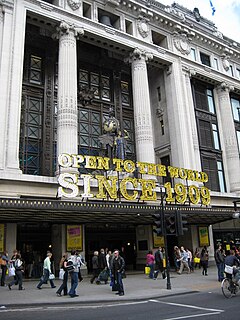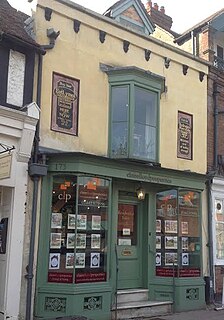
Wickhams was a department store on the north side of the Mile End Road in London's East End, closing in the 1960s.

Wickhams was a department store on the north side of the Mile End Road in London's East End, closing in the 1960s.
The Wickham family were originally drapers, trading from 69, 71 and 73 Mile End Road. [1] No. 75 was occupied by the Spiegelhalter family business of clockmakers and jewellers. With the Wickham's continuing success, in about 1892 the Spiegelhalters agreed to move from 75 to 81 Mile End Road so that the Wickhams could take over and expand into the shop at no. 75.
35 years later the Wickham family had acquired the entire block except the Spiegelhalters' shop at no. 81 and planned a major rebuilding of their shop. They attempted to buy the Spiegelhalter property, but a mutually acceptable price could not be agreed, making the shop a holdout. The Spiegelhalters' refusal to move led to a situation in which the new store was built around the family shop, which continued to trade when Wickhams opened on either side of it. [2]
The two parts of the Wickhams building form part of a greater design, anticipating the eventual purchase of the jewellers and its incorporation into the whole. The building was originally designed to upstage Selfridges department store in Oxford Street, having a colonnaded front but with a central tower and clock that Selfridges did not have. [3]

The contract for the stone façade had been placed before it became apparent that the Spiegelhalters would not sell, so the solution was to erect the right wing shifted to the right by the width of the Spiegelhalters' land. Consequently, the two side wings look very similar with the central raised feature of the entablature (the piece running over, and supported by, the columns) positioned over the fourth window in both wings. If the jewellers had been replaced, the entablature would not have been central on the right hand wing. Also, the central block with its tower would not have been in the centre, with the completed building having seven windows in the left wing and nine in the right.
As can be seen from the photographs, the facade of the building is complete right up to the boundary either side of the jewellers with even the column immediately to the right of the jewellers having a flat side, waiting to be completed once the Spiegelhalters' land had been bought.
Although of German descent from the Black Forest village of Neukirch, the Spiegelhalter family had lived in the East end of London since about 1828 working as jewellers and clockmakers. They had a number of shops before moving to 75 Mile End Road and then onto no. 81. Many family members were born at 81 Mile End Road [4]
Because of anti-German sentiment flowing from the Great War, in 1919 the Spiegelhalters changed their names by deed poll to Salter. [5] The shop, however, retained its original name. [6]
Completion of the grand Wickhams design was never to be. The business was by 1951 owned by Great Universal Stores but was closed down during the 1960s. [7] The Salter family finally closed the shop at 81 Mile End Road in 1982. It was sold and became an off licence. By 2014, the Spiegelhalter shop was derelict and roofless. [6] By 2019, the shop, along with the rest of the Wickhams building, had been refurbished, still with a high gap on the frontage.

The Bull Ring is a major shopping centre in central Birmingham. When combined with Grand Central it is the United Kingdom's largest city centre based shopping centre and has been an important feature of Birmingham since the Middle Ages, when its market was first held. Two shopping centres have been built in the area; in the 1960s, and then in 2003; the latter is styled as one word, Bullring.

Oxford Street is a major road in the City of Westminster in the West End of London, running from Tottenham Court Road to Marble Arch via Oxford Circus. It is Europe's busiest shopping street, with around half a million daily visitors, and as of 2012 had approximately 300 shops. It is designated as part of the A40, a major road between London and Fishguard, though it is not signed as such, and traffic is regularly restricted to buses and taxis.

Bond Street is a London Underground and future Elizabeth line station in Mayfair, in the West End of London. It is located on Oxford Street, near the junction with New Bond Street.

Selfridges, also known as Selfridges & Co., is a chain of high-end department stores in the United Kingdom that is operated by Canadian group Selfridges Retail Limited, part of the Selfridges Group of department stores. It was founded by Harry Gordon Selfridge in 1908.

Harry Gordon Selfridge, Sr. was an American retail magnate who founded the London-based department store Selfridges. His 20-year leadership of Selfridges led to his becoming one of the most respected and wealthy retail magnates in the United Kingdom. He was known as the 'Earl of Oxford Street'.

Whiteleys was a shopping centre in Bayswater, London. It was built in the retail space of the former William Whiteley Limited department store, which opened in 1911 as London's first department store, and was one of the main department stores, alongside Selfridge's, Liberty's and Harrods. The centre's main entrance was located on Queensway.

Houndsditch is a street running through parts of the Portsoken and Bishopsgate Without wards of the City of London; areas which are also a part of the East End of London. The road follows the line of the outside edge of the ditch which once ran outside the London Wall. The road Houndsditch took its name from the section of ditch between Bishopsgate and Aldgate. The name may derive from the widespread dumping of rubbish in this stretch of ditch; relating to the dumping of dead dogs, or the scavenging of the waste by feral dogs.

McWhirters is a heritage-listed former department store at Wickham Street, Fortitude Valley, City of Brisbane, Queensland, Australia. It is also known as McWhirters Marketplace, McWhirters & Son Ltd, and Myer. It was added to the Queensland Heritage Register on 21 October 1992.

The A40 is a major trunk road connecting London to Fishguard, Wales. The A40 in London passes through seven London Boroughs: the City of London, Camden, Westminster, Kensington & Chelsea, Hammersmith & Fulham, Ealing and Hillingdon, to meet the M40 motorway junction 1 at Denham, Buckinghamshire.

Cannondale Historic District is a historic district in the Cannondale section in the north-central area of the town of Wilton, Connecticut. The district includes 58 contributing buildings, one other contributing structure, one contributing site, and 3 contributing objects, over a 202 acres (82 ha). About half of the buildings are along Danbury Road and most of the rest are close to the Cannondale train station .The district is significant because it embodies the distinctive architectural and cultural-landscape characteristics of a small commercial center as well as an agricultural community from the early national period through the early 20th century....The historic uses of the properties in the district include virtually the full array of human activity in this region—farming, residential, religious, educational, community groups, small-scale manufacturing, transportation, and even government. The close physical relationship among all these uses, as well as the informal character of the commercial enterprises before the rise of more aggressive techniques to attract consumers, capture some of the texture of life as lived by prior generations. The district is also significant for its collection of architecture and for its historic significance.

Roosevelt Hall (1903–1907) is an immense Beaux Arts-style building housing the National War College on Fort Lesley J. McNair, Washington, DC, USA. The original home of the Army War College (1907–1946), it is now designated a National Historical Landmark (1972) and listed on the National Register of Historic Places (1972).

A holdout is a piece of property that did not become part of a larger real estate development because the owner either refused to sell or wanted more than the developer would pay. There are many examples of hold-outs in China, Germany, Japan, the United Kingdom, and other countries.

The Selfridges Building is a landmark building in Birmingham, England. The building is part of the Bullring Shopping Centre and houses Selfridges Department Store. The building was completed in 2003 at a cost of £60 million and designed by the architecture firm Future Systems. It has a steel framework with sprayed concrete facade. Since its construction, the building has become an iconic architectural landmark and seen as a major contribution to the regeneration of Birmingham. It is included as a desktop background as part of the Architecture theme in Windows 7.

The John J. Morrill Store is a historic store and Grange hall on Belknap Mountain Road in the central village of Gilford, New Hampshire. Built in the late 1850s, it is a well-preserved example of a period general store with Greek Revival features. The building has also served as the local post office and as a Grange hall. It was listed on the National Register of Historic Places in 1980.

Pollock's Shop House is a heritage-listed general store at 617-619 Stanley Street, Woolloongabba, City of Brisbane, Queensland, Australia. It was built c. 1865. It was added to the Queensland Heritage Register on 21 October 1992.

Cressbrook Homestead is a heritage-listed homestead at off Cressbrook-Caboombah Road, Cressbrook, Somerset Region, Queensland, Australia. It was built from 1841 to 1914. It was added to the Queensland Heritage Register on 21 October 1992.

Rockhampton Post Office is a heritage-listed former post office at 80 East Street, Rockhampton, Rockhampton Region, Queensland, Australia. It was designed by George St Paul Connolly and built from 1892 to 1896 by Dennis Kelleher. It is also known as Rockhampton Post and Telegraph Offices. It was added to the Queensland Heritage Register on 24 January 2003.

173, High Street, Berkhamsted, is a medieval building in Hertfordshire, England. It is considered to be the oldest extant jettied timber framed building in Great Britain, dated by dendrochronology of structural timbers to between 1277 and 1297. At the time of the building's construction, the town of Berkhamsted was a relatively large, flourishing wool trading market town that benefitted from having an important royal castle.

Powis Street is a partly pedestrianised shopping street in Woolwich in the Royal Borough of Greenwich, south east London, England. It was laid out in the late 18th century and was named after the Powis brothers, who developed most of the land in this part of the town. The street has been rebuilt several times but has retained some notable examples of late-Victorian and Art Deco architecture.
On the 19 December 1974 the Provisional IRA exploded a car bomb which was parked opposite to Selfridge's department store on Oxford Street in London. The bomb attack was carried out by an IRA active service unit (ASU) known as the Balcombe Street Gang who carried out some 40 attacks in England between October 1974 - December 1975.
|magazine= (help)Coordinates: 51°31′15.88″N0°3′6.34″W / 51.5210778°N 0.0517611°W